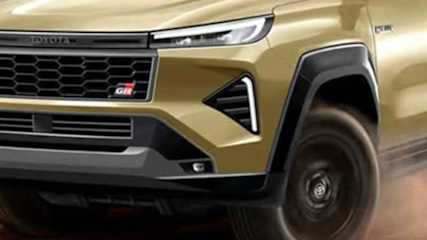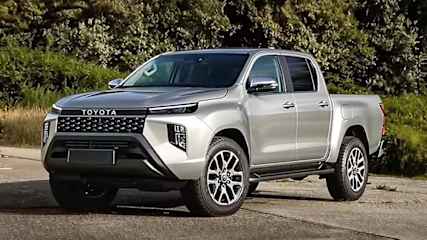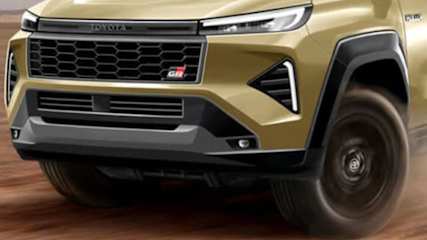Toyota HiLux News
_1.jpg)
Is Toyota cooking up tougher HiLux, Prado?
Read the article
By Dom Tripolone · 20 Oct 2025
Toyota could be prepping a new line of tough four-wheel drives.
.jpg)
2026 Toyota HiLux interior leaked!
Read the article
By Jack Quick · 13 Oct 2025
The new-generation Toyota HiLux is one of the most anticipated vehicle launches in the past 12 months or so and the drip feed of new information continues to flow ahead of its expected reveal at this year’s Thailand motor show.
.jpg)
Are we wrong about EVs and hybrid utes? | Opinion
Read the article
By Laura Berry · 05 Oct 2025
What if electric cars and hybrid utes aren’t the next big thing? Should you buy one or wait for hydrogen? Or do you just stick to petrol and diesel?

Is Australia’s ute addiction harming us?
Read the article
By Byron Mathioudakis · 04 Oct 2025
With the vast majority of utes being diesels, are Australians breathing in more noxious fumes now than 15 years ago? After all, back in 2010, most utes were either of the smaller one-tonne variety or lighter car-based locally-made Holden and Ford Falcon-based models with six-cylinder/V8 petrol options. To find out if Australians breathed easier 15 years ago, we’re comparing the top-three sellers of 2010 with their modern equivalents.

Australia's favourite cars revealed
Read the article
By Dom Tripolone · 03 Oct 2025
Australian new-car sales had another bumper month, with about 106,000 vehicles landing in driveways in September.
.jpg)
New Toyota HiLux exposed in Australian government documents: Next-gen workhorse closes in on showrooms to battle 2026 Ford Ranger, BYD Shark 6 and Isuzu D-Max utes
Read the article
By Dom Tripolone · 30 Sep 2025
A new Toyota HiLux is just around the corner.
.jpg)
What's even the point of 4WDing? Do you really need a Toyota LandCruiser when a 2026 Subaru Forester would do? | Opinion
Read the article
By Laura Berry · 14 Sep 2025
Here’s a question for four-wheel driving enthusiasts: why? As in why do you do it? Serious question.

New 2026 Toyota HiLux: What we know so far about the refreshed Ford Ranger, Isuzu D-Max and BYD Shark 6 fighter
Read the article
By Dom Tripolone · 06 Sep 2025
New car launches don’t get much bigger than a new Toyota HiLux ute.The trusted workhorse has been at the top of the sales charts for the best part of a decade, and a new and improved version is due next year to fight off a wave of new challengers.Details of the new HiLux have started to leak consistently and spy shots have surfaced of a single cab version testing overseas.CarsGuide has joined the dots to get an idea of what this next-generation HiLux will be like.Here’s everything we know so far. Not much to get excited about here, unfortunately.It is believed the HiLux will launch with the same 2.8-litre turbo-diesel motor with 48-volt mild-hybrid assistance found in the current HiLux.It’s unlikely this will be the sole power source for long, with the company making no secret it is working on plug-in hybrid power.Toyota’s new RAV4 will be the brand’s first plug-in hybrid in Australia when it launches next year. That model’s 2.5-litre four-cylinder petrol and electric motor combo deliver 227kW, and while torque is unknown expect it to be in the 500Nm range.That kind of performance eclipses what’s available in the current HiLux.Toyota has pounded the table on many occasions to say its vehicles must be fit for purpose and it won’t rush out a new technology until they are certain it will do what its customers expect.So don’t expect the PHEV version too soon, but it makes sense for it to lob in 2027. This is when the federal government’s New Vehicle Efficiency Standard (NVES) really starts to bite and fines will make diesel-powered ute prohibitively expensive.New spy pics published on Instagram by @Autonetmagz give us an idea of what it may look like.Japanese outlet Best Car has developed some digital renders (seen above) that bring those spy shots to life.The front end is where all the major changes have occurred with the HiLux bringing the brand's new styling language.Sharp, narrow headlights are paired with lower DRLs and a big black grille with hexagon-like design, which is similar to that seen on the new RAV4 and Corolla Cross.The side panels and rear look mostly untouched with big chunky cladding around the wheel arches and side steps.It is also believed to have a step integrated into the tray exterior for easier access.Think of it as an evolution not a revolution.Bigger changes are coming to the cabin, according to design sketches published by Thailand's Headlight Magazine.The design sketches show a focus on in-cabin screens, increased storage, a new dash and vents, and — in a nod to its 4WD siblings — the gear shifter from the Toyota LandCruiser Prado.Hard to say, but nothing new comes cheap.Buyers can probably expect a jump of a few thousand dollars on the current model. This means the cheapest dual-cab pick-up version with the mild hybrid assisted engine will cost close to $65,000 on the road.Toyota is unlikely to give up on the lower end of its range, so buyers can still expect budget focused two-wheel drive single carb models to land in and around the $50,000 range.We haven’t seen the new version yet, which means there is no chance it’ll land in showrooms this year.There is a strong chance it will be revealed at some point this year, which indicates an on sale date of the middle of next year.

3000 reasons new 2026 Toyota HiLux can't come soon enough as Chinese ute competitors from BYD, GWM and JAC circle the dual-cab king
Read the article
By Andrew Chesterton · 31 Aug 2025
At a glance, last month's sales numbers paint a familiar picture of Australia's dual-cab market. The Toyota HiLux was the country's best-selling vehicle in July, with the Ford Ranger the nation's second best-selling ute.

New 2026 Toyota HiLux exposed: Long awaited rival to the Ford Ranger, Isuzu D-Max and BYD Shark 6 surfaces in new spy shots
Read the article
By Dom Tripolone · 26 Aug 2025
The new Toyota HiLux is getting close.





